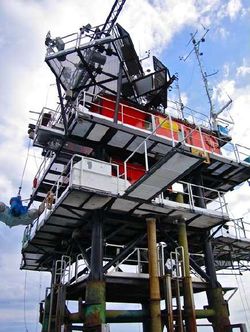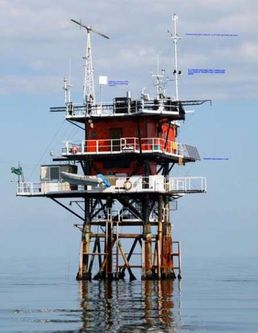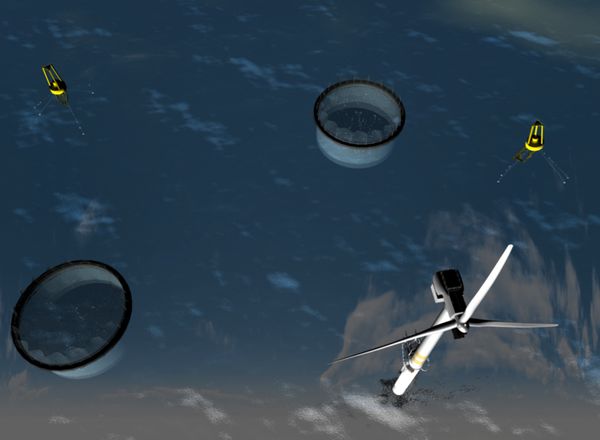Portal:MERMAID/Mediterranean Sea
Introduction Study Site
The activities in the Mediterranean will performed at an existing platform usually adopted for monitoring purposes in the Adriatic Sea (offshore Venice).
The "Acqua Alta" research tower was installed on January 1970 off the Gulf of Venice, Italy, by Micoperi for the CNR. The platform will in include multiple energy converters, i.e. floating and submerged wave energy converters and will be also used as a pilot experimental site for farming target species of invertebrates or seaweeds of commercial, conservation or research interest.

|

|
| The "Acqua Alta" research tower at the Gulf of Venice, Italy | |
Ecological experiments will focus on identifying physical conditions and/or structure configuration that are most likely to facilitate good levels of natural recruitment in the field. Engineering activities will include: reconstruction of wave and wind climate, modelling of the hydrodynamic conditions at the platform, monitoring and optimization of wave energy converters, evaluation of the possible inclusion of wind energy converters, modelling of mooring systems and interactions with the sea-bed. Connection of the energy converters and/or local storage techniques will be also examined.
Cost-benefit analysis of the multi-purpose platform will be performed. If initial activities reveal that the proposed site is not adequate an alternative site will be found. In the identification of the suggested site above, another site at Sicily has also been considered, which could be an alternative site.
| Mediterranean Site Factsheet | |
|---|---|
| Geographical location | Northern Adriatic Sea, off the coast of Venice |
| Offshore distance | 16 km |
| Depth | 16 m, gentle slope towards south east |
| Substrate | A mixture of sand and mud |
| Water temperature | 14°C (+/-6°C) |
| Salinity | 27.5 psu (+/- 1.5 psu) |
| Tidal range | 0.5 m (+/- 0.15 m) |
| Mean wave height | 1.25 m |
| Expected annual wave power | 3 kW/m |
| Average wind speed | 4.54 m/s |
| Expected annual wind power | Large turbines: 12.7 GWh/y / 4 Vestas V112 turbines |
Combination User Functions & Design
The conceptual design of the platform in the Mediterranean site includes wave energy extraction, wind energy extraction and fish farming. Two wave energy extraction devices are being compared: A floating wave energy device measuring 15 m wide and 30 m long, and Wave Star, a fixed system on piles with floaters (3 arms measuring 80 m long and 8 m wide). These two types of wave farms may be combined with the following user functions:
- Large mono-pile turbines (e.g. Vestas V112, 100 m high), to be installed at the boundaries of the wave farm.
- Micro-wind systems, such as a horizontal axis Bergey EXCEL 10 turbine (measuring 25 m high), placed on top of the wave energy converters.
- Sea cages and cables for fish farming (e.g. Mediterranean sea bass (Dicentrarchus labrax) and gilthead sea bream (Sparus auratus)) or mussel farming are being examined.
The study site is characterised by a relatively mild climate, which allows for a safe installation but strongly limits the benefits of a single-purpose installation, both because of the limited available energy and due to the significant distance from the shore as a result of the flat sea bottom. A combination of several user functions is therefore required to create an economically viable solution.
Outlook & Challenges
The proximity of maritime traffic routes and the harbor of Venice offers opportunities to integrate transportation and shipping facilities in the multi-use offshore platform. Furthermore, work is needed on the social perception of these multi-use platforms, the optimised integration of the design and a detailed cost and benefit analysis. The technological challenges are essentially related to the immaturity of wave energy development. More specifically, the design of the mooring system (for the floating wave energy devices), the verification of foundation stability (for Wave Star) and the improved design of the devices and farm layout to maximise energy production deserve further investigation. In addition, a major challenge is to limit the environmental impact. The selection of the construction materials and the maintenance plans should therefore be considered carefully.

